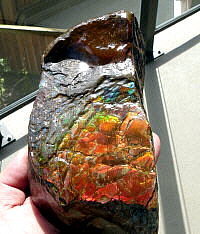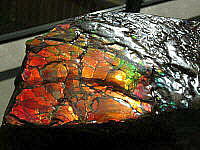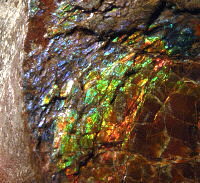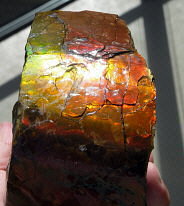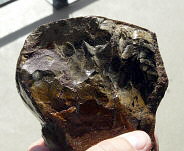Ammolite
by: Michael Schmidt
Ammolite is the scientific name given to the gem material extracted from the
Placenticeras ammonites collected in the Late Cretaceous Bearpaw Shale,
primarily in Southern Alberta. The material is approximately 68-72 MYO. While
iridescent ammonites may be found in other places in the world (Jurassic deposits
in Madagascar and England), they are Not Ammolite. The only place in
the world where ammolite is currently found is the border region of southern
Alberta and Saskatchewan and northern Montana. The specimens shown here were
hand collected, sawn, sanded and finally lacquered to produce the wonderful
display specimens shown in the photos. Ammolite is available in a range of
pattern types and colours, with blues and purples being the rarest, followed
by green, and finally with reds and oranges being the most common. Ammolite
is a very directional gem material, much like labradorite. It may appear red
at one angle, green at another, or yellow at yet another. The gem material
forms as usually very thin layers of bright iridescent material on the shell
of the original ammonite fossil. These specimens were collected along the
banks of the St. Mary's River near Lethbridge, Alberta. Sizes of material
that we are prepping ranges from about an inch to well over a foot in length.
Dragonskin
Ammolite comes in a wide range of colours and patterns. This particular pattern is sometimes referred to as "dragonskin", for obvious reasons. While these dragonskin patterns do run the entire gambit of colours, there is usually a structured colour pattern to the material. What generally happens is the blues and purples will occur on the outside edge of the ammonite. This is usually the thinnest and sparsest of the colouring. It is then followed by green shades, and then terminates in the center of the shell with bright reds and oranges. The further into the center of the ammonite you go, usually the thicker the colour layer is. This is why the blues and purples tend to be the thinnest, followed by the greens, and the reds the thickest. I mentioned the word usually above. The real beauty of this material is that there is so much diversity in colour and patterns that you never know what you are going to end up with!
Vibrant dragonskin pattern. Typical pattern distribution
with the tiniest of blue/purple on the
outside edge, followed by a little bit of chrome green, ending with a core
of a deep scarlet red.
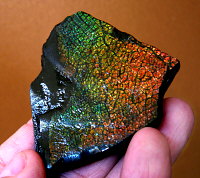
Notice how the green colours (and the tiniest hint
of blue)
are closer to the outer rim of the shell.
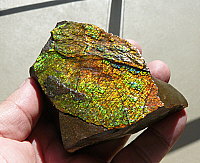
Another dragonskin pattern. This time the colours
are less distinct,
and have blended to create some green-orange-red tones.
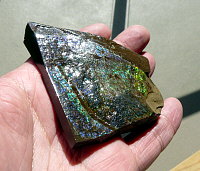

Two more pieces of this type. One is a little hard
to make out (these are sometimes
very difficult to photograph), however, one can see in both the outside blue
patterns,
followed by green, with one piece very clearly showing the red "core".
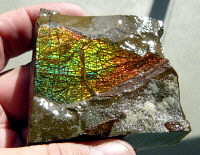
This is a good diagnostic specimen, as it shows the
clearly defined outside rim of the actual ammonite fossil.
Sheet
This type of ammolite is often called "sheet"
material, and is very uniform in colour. It is called this because it often
has the appearance of a material similar to mica-thin sheets of colour attached
to a host rock matrix. Sometimes the material is just a very bright red colour,
while sometimes the material is multicoloured and one colour simply blends
into the next. It does however lack the small, individual cell structure that
dragonskin patterns exhibit, and result is distinctively different. As with
the dragonskin material, a full range of colours is present- blues and purples
being the rarest, followed by greens, and with reds/yellows/oranges being
the most common. Very occasionally some of the material will present a "foil"
type of look. It's a little hard to explain, but it is very distinctive when
it occurs. I suppose one could describe it as a sharper, more crisp and vibrant
colour than some of the other sheet material. When it does occur, it is incredible!
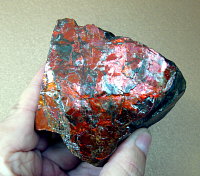

An interesting piece, and demonstrates very clearly
the directionality of the colour
of this material. Head on, the material is a bright scarlet red. However,
if the piece
is rotated slightly, the surface seems to take on a bright green colour. If
you played
around with the angles enough, you might even get it to appear a yellowish
colour as well.
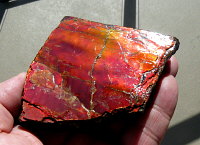

Two nice examples of sheet material, showing very
distinctive red and orange colours.
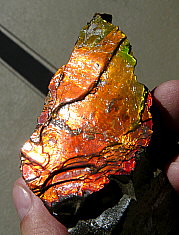
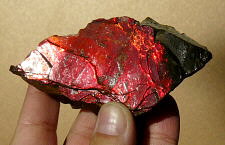
A very attractive piece, and again shows the extreme
angular colour shift
of some of this material. In case you missed it, this is the same specimen,
photographed at two slightly different angles.
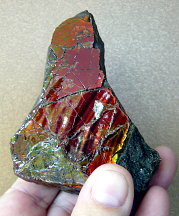

A red-orange coloured specimen. Second photo taken
in indirect light. While
it shows the base colour of the piece, it demonstrates how reflective this
material is.
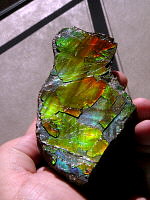
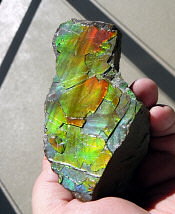
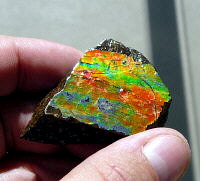
Very nice multicoloured and bright specimen.

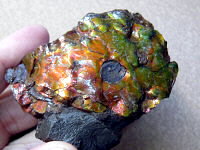
This is what I would call one of the "foil"
looking specimens. This one also happens
to have some bite marks from a mosasaur in it. If you look closely around
the edges
of the holes, you can see compression "crumpling" of the shell.
Oranges, greens,
and some blue can clearly be seen.
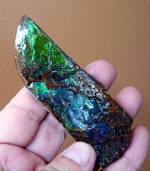
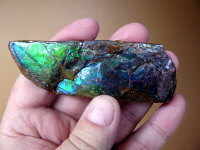
A beautiful example of the foil type. This is the
rarest kind of ammolite you'll really
ever see; the purple/blue combinations. Most of them will often have some
green
associated with them, as this one does. There is just such a metallic foil
look to them,
the type of effect that you see in those foil enhanced glass beads.

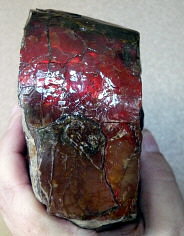
This is a cool piece, and is a large section of a
very bulbous .
Again, the colour changes from a bright red to a greenish and
sometimes orangish colour, depending on the angle of viewing.
Contact: information - specimens
Michael Schmidt
dm.schmidt@shaw.ca
Vancouver, Canada
Go-Back Text
Menu or Thumb
Menu
Home
Page
Photo
Album search engine
search the Photo Album or the Web
